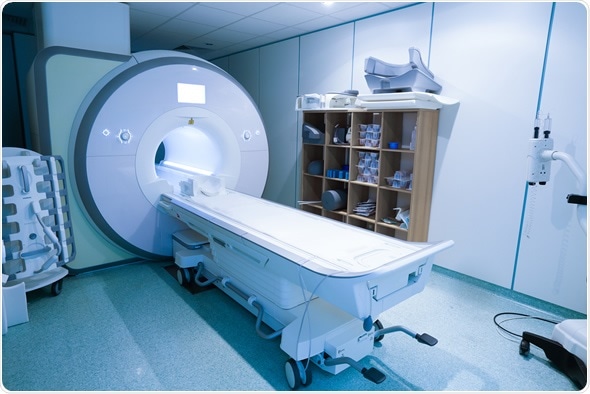Spectroscopy represents a scientific measurement technique for the studying of matter through its interaction with different components of the electromagnetic spectrum. It can measure light by breaking it down into its component colors with the help of a prism in order to study the resulting spectrum.
The concept was later expanded to include any feasible interaction with radiative energy as a function of its frequency or wavelength.
The outcome of such an interaction allows researchers to infer analytical information on the atomic or molecular structure of the matter.
A wide array of different spectroscopic techniques can be applied in virtually every domain of scientific research - from environmental analysis and biomedical sciences to space exploration endeavors.

Magnetic resonance spectroscopy machine in hospital laboratory : Image Copyright: zlikovec / Shutterstock
Spectroscopy in Environmental Analysis
Visible and ultraviolet spectroscopic methods have been used for years by environmental scientists.
Common colorimetric tests that probe different water properties (such as acidity) are now available in simple kit forms, employing visual color matching or portable colorimeters.
Emission spectroscopy or atomic absorption in the visible and ultraviolet regions can be used to determine metals in samples of water or solids.
These approaches require immersion of the analyte into solution before analysis can be pursued. Nevertheless, certain solid or semisolid samples may be analyzed directly with atomic absorption spectrometry (by using electrothermal atomization)
Infrared spectroscopy is also a significant addition to the environmental analysts’ armamentarium, especially with the introduction of long-range infrared sensors that can determine the concentration of certain compounds in the air mass.
In addition, ultraviolet long-path methods are also increasingly used, albeit not as habitually as infrared spectroscopy.
X-ray methods (such as X-ray fluorescence) can be used to determine the atomic composition of solid materials, and they also found a place in determining metal concentrations in particulate matter from the air, as well as in soil samples.
Microwave region spectroscopy and magnetic resonance spectroscopy have been implemented in some environmental research, but are not so pervasive.
Spectroscopy in Biomedical Sciences
The biomedical use of light comprises numerous diagnostic and therapeutic applications. Photon time-of-flight spectroscopy may assist certain therapeutic methods (such as photodynamic therapy) by supplying them with the data on the optical properties governing tissue response.
The reliable absorption and scattering spectroscopy (provided by the time-of-flight spectroscopy) can be of great value in diagnostics as well, which is confirmed by its recent introduction to microbiology.
Moreover, steady-state, near-infrared spectroscopy is a very significant tool in pharmaceutical analysis.
The main advantage of this technique is a rapid and non-destructive approach that necessitates little or no sample preparation. In addition, the establishment of chemometrics (extracting information by data-driven means) has increased its propensity of sensing slight variations in complex datasets.
Recent breakthroughs in holographic microspectroscopy (a technique based on optical coherence tomography or quantitative phase imaging) hold promise for non-invasive, label-free optical detection and measurement of specific molecules in human cells and tissues (such as hemoglobin protein).
Other Applications
Spectroscopy also finds uses in astronomy to obtain information about the composition, density, temperature, and other principal physical processes of a certain astronomical object.
By measuring red-shift (recession speed), scientists can use spectroscopy to calculate the relative velocities of supernovae and galaxies.
Raman spectroscopy can result in the vibrational spectrum of a certain analyte (often referred to as its “fingerprint”), which then allows straightforward identification and interpretation. Its potential applications range from archaeology to modern nanotechnology.
Further Reading